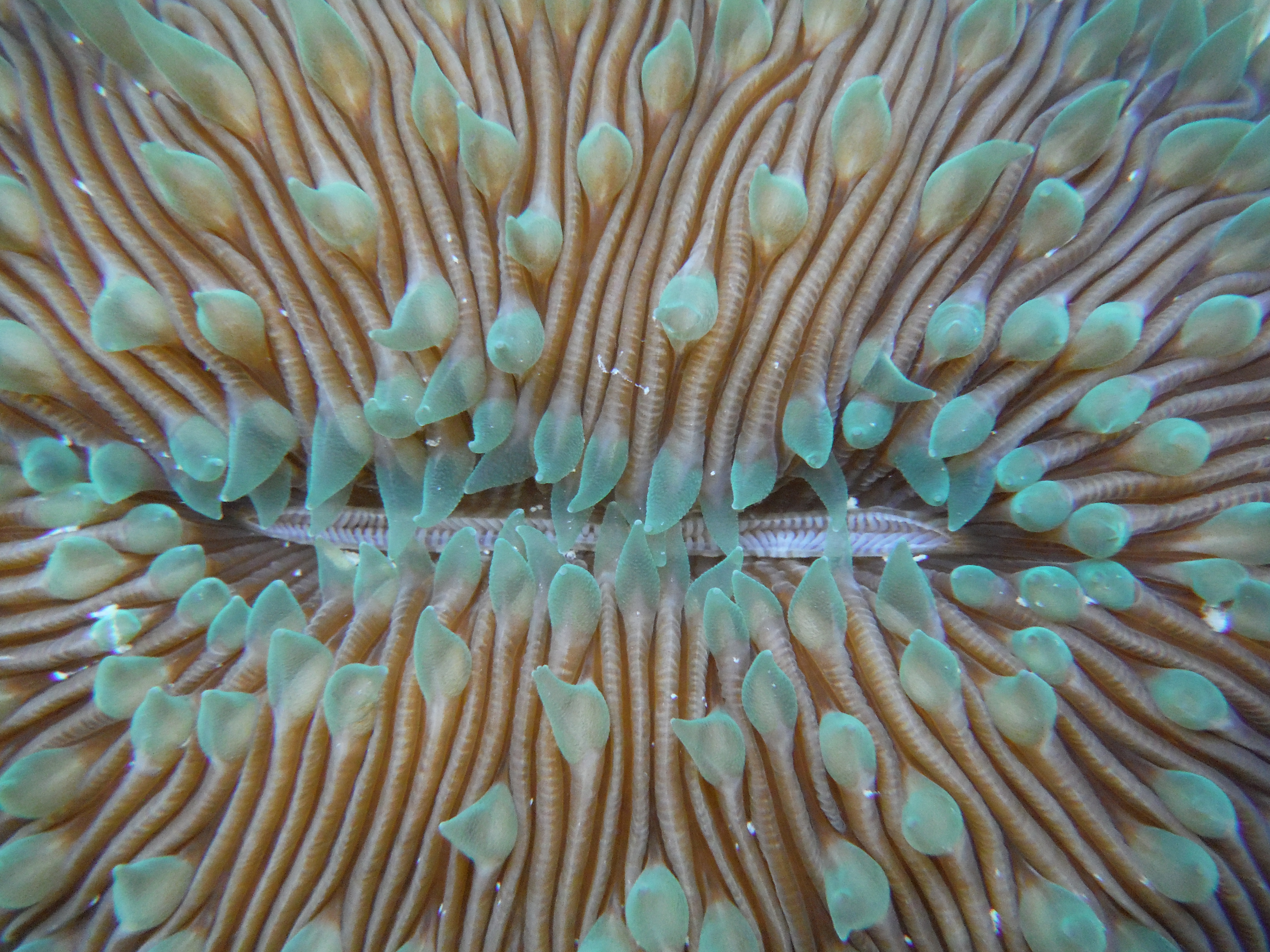Fungia scutaria on:
[Wikipedia]
[Google]
[Amazon]
''Lobactis'' is a
Corals of the World online. Retrieved 2011-12-14. and is embedded in a cup shaped hollow known as a
Reef coral genera of the Western Indian Ocean. Retrieved 2011-12-14.Plate Coral- ''Fungia scutaria''
LHS Virtual Zoo. Retrieved 2011-12-14.
 ''Lobactis scutaria'' is a
''Lobactis scutaria'' is a
genus
Genus (; : genera ) is a taxonomic rank above species and below family (taxonomy), family as used in the biological classification of extant taxon, living and fossil organisms as well as Virus classification#ICTV classification, viruses. In bino ...
of plate or mushroom coral in the family Fungiidae. The genus is monotypic with a single species, ''Lobactis scutaria'', that is found in the Indo-Pacific
The Indo-Pacific is a vast biogeographic region of Earth. In a narrow sense, sometimes known as the Indo-West Pacific or Indo-Pacific Asia, it comprises the tropical waters of the Indian Ocean, the western and central Pacific Ocean, and the ...
region.
Description
''Lobactis scutaria'' is a solitary, non-colonialcoral
Corals are colonial marine invertebrates within the subphylum Anthozoa of the phylum Cnidaria. They typically form compact Colony (biology), colonies of many identical individual polyp (zoology), polyps. Coral species include the important Coral ...
that is free living and not attached to the seabed
The seabed (also known as the seafloor, sea floor, ocean floor, and ocean bottom) is the bottom of the ocean. All floors of the ocean are known as seabeds.
The structure of the seabed of the global ocean is governed by plate tectonics. Most of ...
. It is discoid or elongated in shape and can grow to a very large size. The polyp can be up to long ''Fungia scutaria''Corals of the World online. Retrieved 2011-12-14. and is embedded in a cup shaped hollow known as a
corallite
A corallite is the skeletal cup, formed by an individual stony coral polyp, in which the polyp sits and into which it can retract. The cup is composed of aragonite, a crystalline form of calcium carbonate, and is secreted by the polyp. Corallit ...
, surrounded by calcareous material. Lining this are narrow ribs known as septa
SEPTA, the Southeastern Pennsylvania Transportation Authority, is a regional public transportation authority that operates bus, rapid transit, commuter rail, light rail, and electric trolleybus services for nearly four million people througho ...
, each having a tall tentacular lobe near its origin in the centre. The septa bear unlobed teeth and further tentacular lobes at intervals where the septa divide. Outside the corallite the ribs continue, now known as costae, bearing rows of tiny spines. The underside of the coral bears a scar resulting from its detachment from the sea bed as a juvenile. The colour varies, often being brown, yellowish or blue with contrasting tentacular lobes. The polyp has a central, slit-like mouth and a small number of short, tapering tentacle
In zoology, a tentacle is a flexible, mobile, and elongated organ present in some species of animals, most of them invertebrates. In animal anatomy, tentacles usually occur in one or more pairs. Anatomically, the tentacles of animals work main ...
s.''Fungia'' (mushroom coral)Reef coral genera of the Western Indian Ocean. Retrieved 2011-12-14.Plate Coral- ''Fungia scutaria''
LHS Virtual Zoo. Retrieved 2011-12-14.
Distribution and habitat
''Lobactis scutaria'' occurs in the Indian Ocean on upper reef slopes especially where there is considerable movement of the water as a result of wave action. It is usually found on sand or beds of coral fragments. It is often associated with other species of '' Fungia''.Biology
carnivore
A carnivore , or meat-eater (Latin, ''caro'', genitive ''carnis'', meaning meat or "flesh" and ''vorare'' meaning "to devour"), is an animal or plant
Plants are the eukaryotes that form the Kingdom (biology), kingdom Plantae; they ar ...
and catches plankton
Plankton are the diverse collection of organisms that drift in Hydrosphere, water (or atmosphere, air) but are unable to actively propel themselves against ocean current, currents (or wind). The individual organisms constituting plankton are ca ...
, shrimp
A shrimp (: shrimp (American English, US) or shrimps (British English, UK)) is a crustacean with an elongated body and a primarily Aquatic locomotion, swimming mode of locomotion – typically Decapods belonging to the Caridea or Dendrobranchi ...
s and fish
A fish (: fish or fishes) is an aquatic animal, aquatic, Anamniotes, anamniotic, gill-bearing vertebrate animal with swimming fish fin, fins and craniate, a hard skull, but lacking limb (anatomy), limbs with digit (anatomy), digits. Fish can ...
with its tentacles.
''Lobactis scutaria'' is a hermaphrodite
A hermaphrodite () is a sexually reproducing organism that produces both male and female gametes. Animal species in which individuals are either male or female are gonochoric, which is the opposite of hermaphroditic.
The individuals of many ...
. Eggs and sperm are ejected through the mouth and after fertilisation, develop into planula
A planula is the free-swimming, flattened, ciliated, bilaterally symmetric larval form of various cnidarian species and also in some species of Ctenophores, which are not related to cnidarians at all. Some groups of Nemerteans also produce larva ...
larvae which form part of the plankton. After some time these settle on the seabed and undergo metamorphosis
Metamorphosis is a biological process by which an animal physically develops including birth transformation or hatching, involving a conspicuous and relatively abrupt change in the animal's body structure through cell growth and different ...
. The juveniles attach themselves to the substrate
Substrate may refer to:
Physical layers
*Substrate (biology), the natural environment in which an organism lives, or the surface or medium on which an organism grows or is attached
** Substrate (aquatic environment), the earthy material that exi ...
and start feeding, extruding their hard skeletons and growing. At a later stage they become detached from their base and drift around on the sea bed. The polyps feed by day as well as by night.
References
{{Taxonbar, from1=Q18592708, from2=Q3331883 Fungiidae Animals described in 1801 Monotypic cnidarian genera